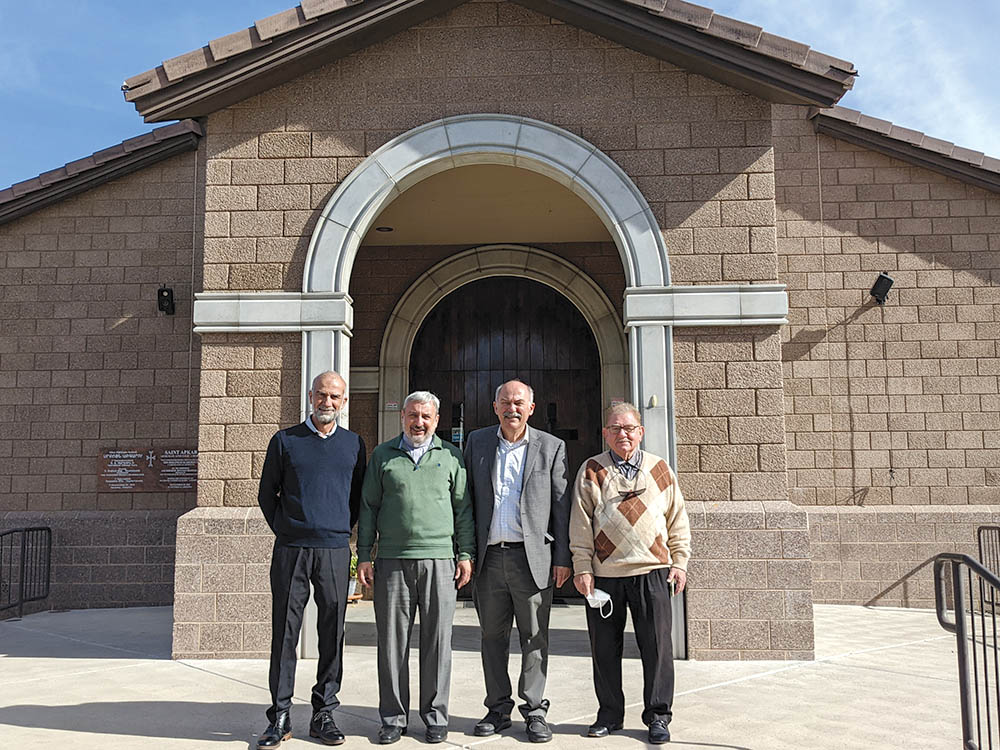
Photo: ASP Archive
Sosse Baloian
Staff Writer
“We know about our identity from reading the stories of our writers,” said Professor Barlow Der Mugrdechian. “Without that literature and history, it would be difficult to understand Armenian identity.”
On Sunday, January 16, 2022, Prof. Der Mugrdechian gave a talk on “Armenian Literature and Identity” at St. Apkar Armenian Apostolic Church in Scottsdale, Arizona. Prof. Der Mugrdechian is the Berberian Director of the Armenian Studies Program at Fresno State and has been teaching courses in Armenian literature and history for more than thirty-six years.
Prof. Der Mugrdechian began his talk by defining identity as the distinguishing characteristics of an individual or a society/culture. He said Armenian identity is both: 1) how the Armenians see themselves and 2) how others see the Armenians.
The creation of the Armenian alphabet by Mesrop Mashtots in the early 5th c. AD ignited a mass production of both translated and original Armenian literature. Our understanding of the early identity of the Armenians comes from the contributions of 5th c. A.D. Armenian historians such as Agatangelos, Movses Khorenatsi, and Yeghishe.
Agatangelos was a historian who chronicled the Christianization of the Armenians during the early 4th c. AD. Armenians acquired a Christian identity in addition to their pre-Christian identity. Christianity was a way of distinguishing Armenians from their Persian neighbors and in time from their Byzantine Christian neighbors. Christianity is a fundamental aspect of Armenian identity today.
Movses Khorenatsi, also known as “The Father of Armenian History,” was a 5th c. A.D. historian who wrote History of the Armenians. Khorenatsi tied the origin of the Armenians to the Biblical story of the flood by connecting the Armenian lineage to Noah. He wrote that Armenians were descendants of Hayk who was the “Patriarch of the Armenians.” Some have associated Hayk’s name with the word “hay” meaning Armenian people in the Armenian language. By the 6th c. BC, the territory where Armenians lived was referenced by Greek and Persian sources as “Armenia,” which indicates that Armenians already possessed a unique identity.
Yeghishe was a historian who chronicled the story of the 451 AD battle with the Persians in his most famous work Vartan and the Armenian War. This narrative demonstrated that Armenians were willing to die for their Christianity instead of converting to Zoroastrianism. Prof. Der Mugrdechian paraphrased Yeghishe’s famous message, “If you don’t know why you are going to die, that is death. But if you know the purpose in your dying, that is immortality.” Yeghishe’s work united Armenian Christianity with Armenian culture and formed a “national” identity.
From the 16th c. until the 20th c. Armenians lived either under the Ottoman Turkish Empire or the Persian, and later Russian Empire. Prof. Der Mugrdechian asked, “How did the Armenians maintain their identity while living more than four centuries under foreign rule?” The maintenance of the Armenian Church, continuation of Armenian literature/history, the role of education for those who lived in the Diaspora, the remnants of nakharar leaders, and the role of merchants in taking on leadership roles all contributed to the preservation of Armenian identity during a time when there was no independent Armenian state. Because of these factors, Armenians were recognized as a people with a special status by the Empires they lived under.
For the Western Armenians, who had been living under Ottoman Turkish rule since the 16th century, a literary revival began in Constantinople in the middle of the 19th century. This period of Western Armenian revival is known as the “Zartonk” period. The first writer of this period was the poet, Bedros Tourian (1851-1872), whose works and the works of other authors who followed him, began to shape a more modern concept of Armenian identity. Even though the Western Armenians were politically under the Ottoman Turks, Armenian literature began to flower. The Armenian sense of identity was expressed through literature.
Misak Medzarents, whose career was cut short by illness, was another outstanding poet of the prerevolution period. His collected work, Misak Medzarents: The Complete Lyric Poems, translated by Dr. James Russell, was recently published by the Armenian Series at Fresno State.
The Ottoman Turkish revolution of July 1908 brought hopes for a truly equal society in the Ottoman Empire. The Sultan was overthrown and an Ottoman parliament was elected which ignited the Western Armenian Renaissance (1908-1915).
Some of the writers of the time were: Daniel Varoujan, Krikor Zohrab, Rupen Zartarian, Tlgadintsi, and Rupen Sevak. Sadly, the atmosphere of cosmopolitanism that was an outgrowth of the revolution was stamped out by the militaristic/totalitarian elements of the Committee of Union and Progress. This change ultimately led to the Armenian Genocide and the murder of these Western Armenian Renaissance writers.
One of the writers who managed to escape the genocidal persecution was Zabel Yessayan (1878-1943?), an author, humanitarian, and activist who was born in middle-class Ottoman Istanbul. In 1909, she was appointed by the Patriarchate of Constantinople as part of a delegation sent to Adana to aid orphans and assess and to report on conditions in Cilicia after the massacres. She recorded her experiences in her book, In the Ruins: The 1909 Massacre of the Armenians of Adana. She later repatriated to Soviet Armenia and most likely died in Stalin’s gulag (prison). Yessayan’s Captive Nights: From the Bosphorus to Gallipoli with Zabel Yessayan, translated by G. M Goshgarian and with an introduction by Nanor Kebranian, was recently published as volume 14 in the Armenian Series, under the general editorship of Prof. Der Mugrdechian.
Armenian identity is a story of perseverance. Armenians refused to turn away from their faith and they evaded assimilation under various empires.
The expanse of the Armenian diaspora serves as a symbol of our refusal to submit to annihilation during the Genocide. Armenian writers from the 5th c. AD to the 21st c. capture this essence of perseverance and help us understand our identity.
 Hye Sharzhoom Armenian Action
Hye Sharzhoom Armenian Action